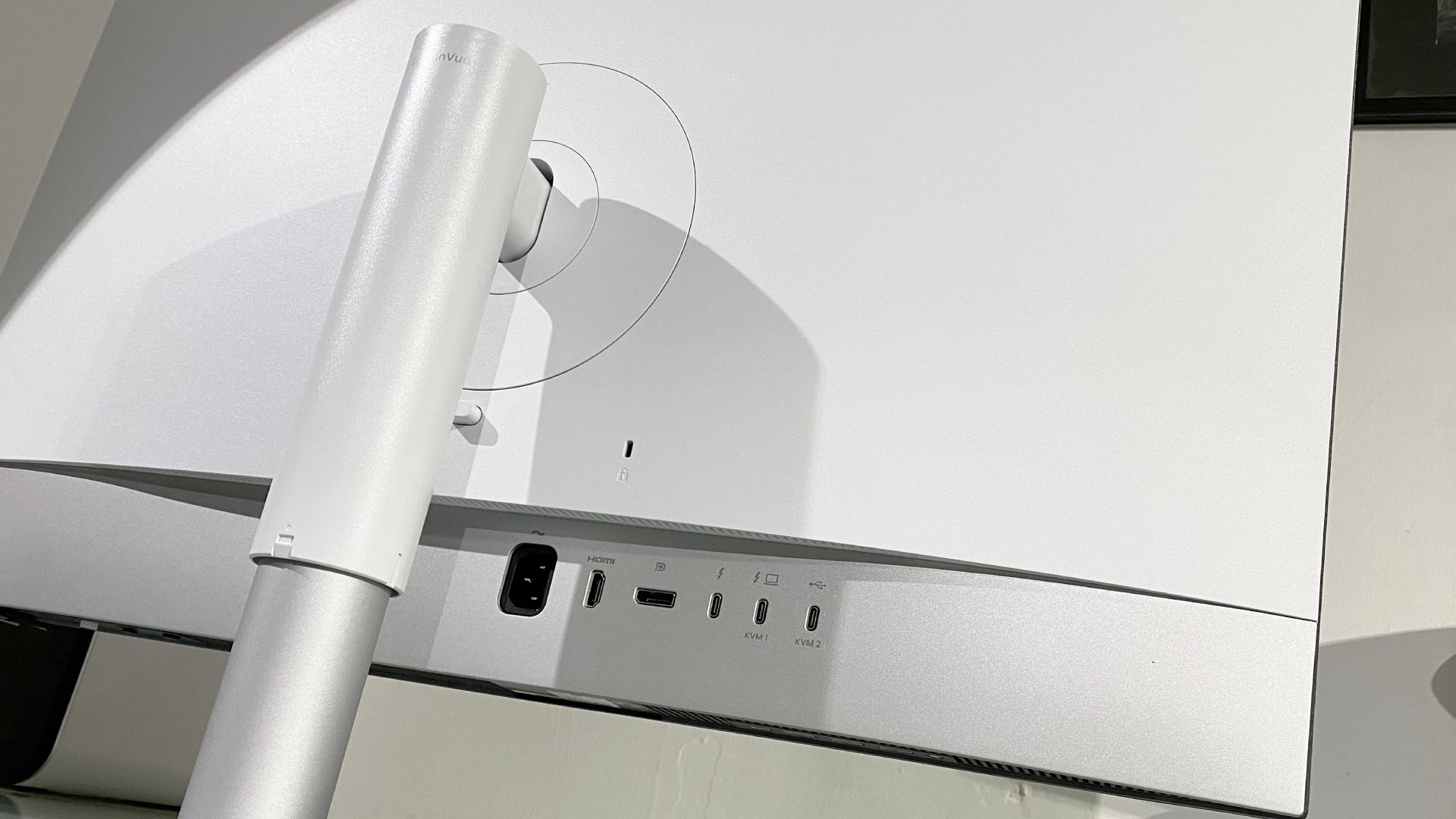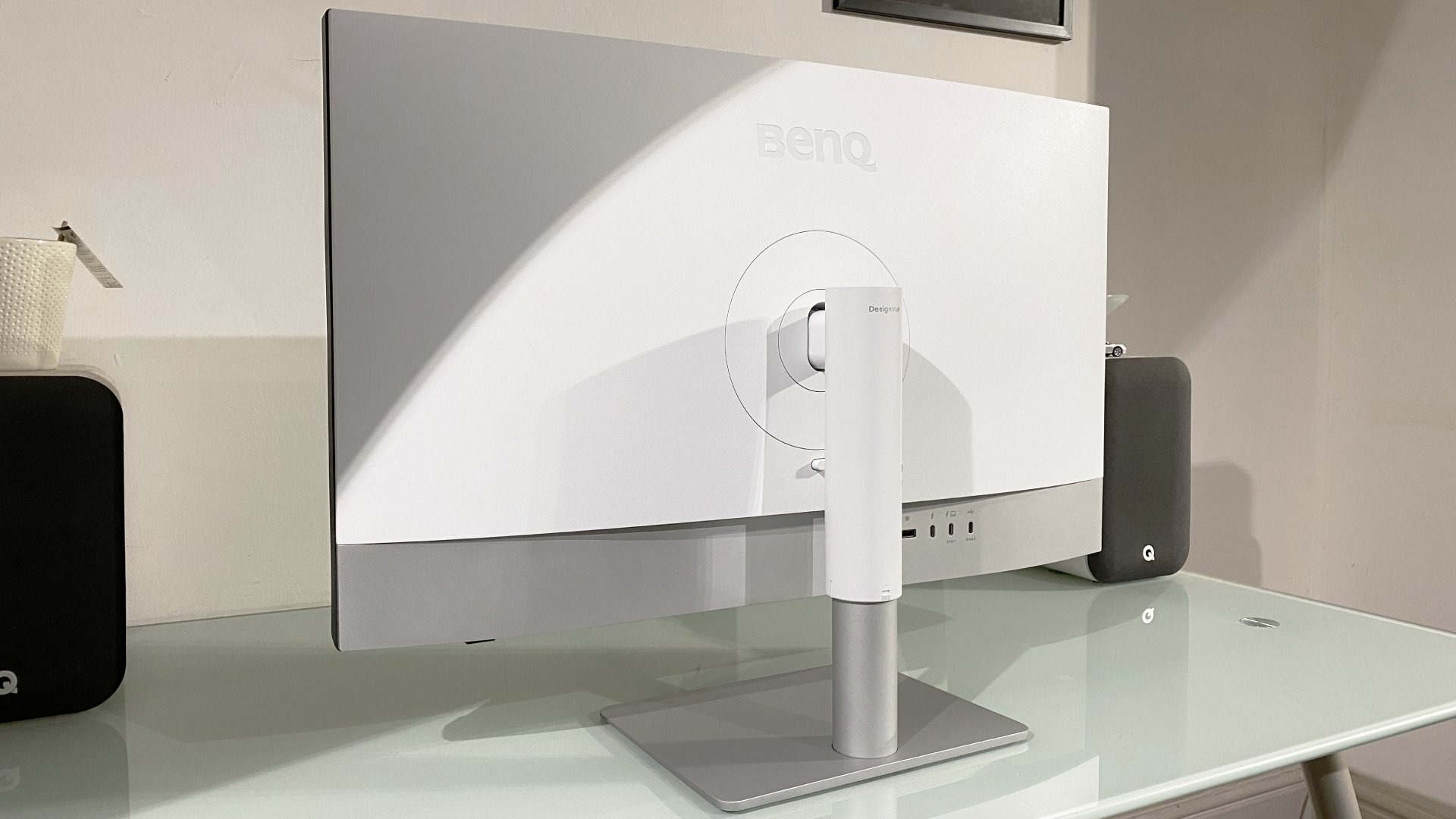Our Verdict
BenQ's latest 32-inch 4K panel for creative pros is more than just a routine upgrade thanks to the addition of 144Hz refresh for a super slick and responsive feel. It also offers absolutely fantastic connectivity. However, it's painfully pricey and only offers limited HDR performance.
For
- Lovely 4K IPS panel
- 144Hz refresh
- Outstanding connectivity
Against
- Limited HDR support
- Painfully pricey
- Pointless built-in speakers
Why you can trust Creative Bloq
Want support for higher refresh rates of 120Hz-plus from a display aimed at creative pros? Good luck with that. Even Apple's Studio Display and Pro Display XDR are limited to a mere 60Hz. However, BenQ's latest 32-inch 4K creator monitor fixes that with slick 144Hz capability, plus an absolutely fantastic array of connectivity including Thunderbolt 4 and a KVM switch. But boy will that fab feature set cost you! At $1,299/£1,099, this is not a budget display, and with its feature set is more likely to feature in our list of the best monitors for video editing than a best budget list. Time to find out if the BenQ PD3226G is worth the steep sticker price.
Key specifications
Screen size: | 32in |
Screen type: | IPS |
Resolution: | 3840x2160 |
Max refresh rate: | 144Hz |
Connectivity: | DisplayPort 1.4, HDMI 2.0, Thunderbolt 4 / USB-C in with 90W PD, USB-A hub, 3.5mm audio |
Brightness: | 400 nits |
Colour response: | 95% P3 |
HDR: | HDR 400 |
Webcam: | No |
Speakers: | 2x 3W |
Adjustments: | +20º to -5º tilt; + 90° pivot; +/- 30° swivel; 150mm height |
Dimensions: | 714mm x 242mm x 486mm |
Weight: | 9.7kg (with stand) |

Design and build
• Slick, minimalist design
• Easy-access ports
If this latest member of BenQ's monitor line for creatives looks awfully familiar, that's because it maintains the brand's signature design vibe. And that's a good thing if you like a slick, minimalist aesthetic with slim bezels. The BenQ PD3226G will look like a class act on top of just about any work surface.
That said, you only get slim bezels on three sides of the 32-inch 4K IPS panel. The lower chin is a little chunky, though the all-metal stand not only looks crisp and modern. It's also extremely sturdy and allows for a full range of adjustment, including height, tilt, swivel and pivot into portrait mode.
Another ergonomic highlight involves the generous port selection on the rear of the chassis. The power, HDMI, DisplayPort and trio of USB-C inputs (which include Thunderbolt 4 support) sit flush on the rear rather than underneath the lower bezel, which makes for super-simple connectivity.
There's also another collection of connectors on the lower surface of the bottom bezel, including USB-C data port, a triple-port USB-A hub and 3.5mm audio. Whether those ports would also be better situated on the rear is an open question. But your connectivity needs are certainly very well covered.
Design score: 4.5/5

Features and performance
• Gorgeous 144Hz panel
• Comprehensive connectivity and wireless IR remote
The BenQ PD3226G ticks a lot of the usual creator-friendly boxes when it comes to features and performance. It's calibrated to well below a Delta E of 1 from the factory, offers decent but not spectacular colour coverage of 95% DCI-P3 and is both Pantone Validated and Calman verified. Nice.
Of course, it's also a 32-inch 4K model, which means lots of screen real estate and good pixel density of around 140DPI. That makes for really nice, crisp fonts, especially in MacOS. The basic image quality from the IPS panel is also seriously sweet, with all the key colour modes, including DCI-P3 and sRGB, looking bang-on right out of the box.
There's also an M-Book mode that's claimed to match the factory calibration of Apple's MacBook laptops. However, given MacBooks default to P3 and BenQ also includes a dedicated P3 mode, it's unclear what benefit the M-Book mode actually brings.
Whatever, this is a fantastic looking panel with natural, accurate colours and great viewing angles that can turn its hand to most creative workflows. However, it's not a true pro-grade monitor when it comes to image and video editing. But then such monitors cost a whole lot more money.
As for the 144Hz refresh, it's supported over both HDMI and DisplayPort, the latter also incorporating DisplayPort alt mode over the Thunderbolt 4 interface. Obviously, 144Hz isn't a must have for most workflows. But for some specific digital artwork tasks, for instance when using a drawing tablet and similar input devices, high refresh seriously boosts response and accuracy. What's more, 144Hz makes this monitor a pleasure to use, day-to-day. Compared to 60Hz, everything feels so much snappier and responsive.
The PD3226G's other obvious upside is connectivity. The inclusion of Thunderbolt 4 enables support for daisy chaining a second monitor and connecting everything to your PC or Mac via a single USB-C cable. The KVM switch also means you can easily share this monitor across two machines.
Oh, and the IR control puck remote control is a very nice extra, too. It's wireless and powered by a pair of triple-A batteries, which is a real boon in terms of keeping desk clutter under control. It has a lovely tactile metal dial plus shortcut buttons and makes changing settings a cinch.
As for drawbacks, well, the most obvious is limited HDR support. There's no local dimming and the brightness tops out at 400 nits. In that regard, and also in terms of the usual IPS-grade black levels, which aren't great, an OLED monitor will blow this BenQ away. The integrated speakers are also so feeble, BenQ would have been better off not bothering with them.
Features and performance score: 4/5

Price
At $1,299 in the US and £1,099 in the UK, this is one pricey IPS panel. That's especially true when you consider that it offers limited HDR support and makes for an uncomfortable comparison with the latest 32-inch 4K OLED monitors. However, few if any of those offer the comprehensive connectivity of this BenQ or features like its nifty 1R remote control.
Value score: 3/5
Who is it for?
• Creatives who don't require HDR
High-refresh monitors used to be the preserve of gamers. But BenQ has recognised the broader benefits of 144Hz. Creative pros of all creeds will appreciate the slick feel of this lovely 32-inch 4K model. They'll also benefit from the excellent connectivity. The exception is anyone who needs true HDR support. That's simply not on offer here.
Attributes | Notes | Rating |
|---|---|---|
Design and build: | A quality item with great ergonomics | 4.5/5 |
Features and performance: | 144Hz refresh and great connectivity | 4/5 |
Value: | Expensive given the limited HDR support | 3/5 |

Buy it if...
- You want great connectivity
- You appreciate high refresh rates
- You don't need true HDR support
Don't buy it if...
- You demand serious bang for your buck
- You need proper HDR support
- You're expecting OLED-like black levels
Also consider
One of the brightest, sharpest, most professional-ready 4K monitors on the market, whether you work in video, photography, graphic design or animation.
This curved OLED will attract gamers, but with the Acer Predator X32X QD-OLED's top-end colour reproduction, there's a lot to like for studio dwellers, too. There's a lot of competition at this price point, though, and the spectre of the Apple Studio Display isn’t too far off.
An interesting screen for creatives, and its image quality is great, but it doesn’t live up to its potential. Lack of HDR, limited ports and an underwhelming webcam means the asking price will be too high for many.
out of 10
BenQ's latest 32-inch 4K panel for creative pros is more than just a routine upgrade thanks to the addition of 144Hz refresh for a super slick and responsive feel. It also offers absolutely fantastic connectivity. However, it's painfully pricey and only offers limited HDR performance.

Jeremy has been writing about technology since the 90nm Netburst era (Google it!) and enjoys nothing more than a serious dissertation on the finer points of input lag and overshoot followed by a forensic examination of advanced lithography. Or maybe he just loves machines that go 'ping!'. He has written for a variety of publications, including TechRadar, The Independent, Digital Camera World, T3, PC Gamer, GamesRadar+.
You must confirm your public display name before commenting
Please logout and then login again, you will then be prompted to enter your display name.




